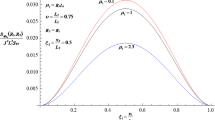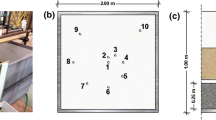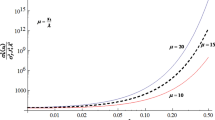Abstract
Average steady source flow in heterogeneous porous formations is modelled by regarding the hydraulic conductivity K(x) as a stationary random space function (RSF). As a consequence, the flow variables become RSFs as well, and we are interested into calculating their moments. This problem has been intensively studied in the case of a Neumann type boundary condition at the source. However, there are many applications (such as well-type flows) for which the required boundary condition is that of Dirichlet. In order to fulfill such a requirement the strength of the source must be proportional to K(x), and therefore the source itself results a RSF. To solve flows driven by sources whose strength is spatially variable, we have used a perturbation procedure similar to that developed by Indelman and Abramovich (Water Resour Res 30:3385–3393, 1994) to analyze flows generated by sources of deterministic strength. Due to the linearity of the mathematical problem, we have focused on the explicit derivation of the mean head distribution G d (x) generated by a unit pulse. Such a distribution represents the fundamental solution to the average flow equations, and it is termed as mean Green function. The function G d (x) is derived here at the second order of approximation in the variance σ2 of the fluctuation \(\varepsilon \left({{\mathbf{x}}}\right) = 1- \frac{K{\left({{\mathbf{x}}}\right)}}{K_{A}}\) (where K A is the mean value of K(x)), for arbitrary correlation function ρ(x), and any dimensionality d of the flow domain. We represent G d (x) as product between the homogeneous Green function G (0) d (x) valid in a domain with constant K A , and a distortion term Ψ d (x) = 1 + σ2ψ d (x) which modifies G (0) d (x) to account for the medium heterogeneity. In the case of isotropic formations ψ d (x) is expressed via one quadrature. This quadrature can be analytically calculated after adopting specific (e.g.. exponential and Gaussian) shape for ρ(x). These general results are subsequently used to investigate flow toward a partially-penetrating well in a semi-infinite domain. Indeed, we construct a σ2-order approximation to the mean as well as variance of the head by replacing the well with a singular segment. It is shown how the well-length combined with the medium heterogeneity affects the head distribution. We have introduced the concept of equivalent conductivity K eq(r,z). The main result is the relationship \(\frac{K^{\rm eq}\left(r,z\right)} {K_{A}} = 1-\sigma^{2}\psi^{\left(w\right)}\left(r,z\right)\) where the characteristic function ψ(w)(r,z) adjusts the homogeneous conductivity K A to account for the impact of the heterogeneity. In this way, a procedure can be developed to identify the aquifer hydraulic properties by means of field-scale head measurements. Finally, in the case of a fully penetrating well we have expressed the equivalent conductivity in analytical form, and we have shown that \(K^{({\rm efu})}\leq K^{\rm eq}\left(r\right) \leq K_{A}\) (being \(K^{({\rm efu})}\) the effective conductivity for mean uniform flow), in agreement with the numerical simulations of Firmani et al. (Water Resour Res 42:W03422, 2006).







Similar content being viewed by others
Abbreviations
- C h (x,y):
-
head-covariance
- C Kh (x,y):
-
cross-covariance between the conductivity and head
- d :
-
domain dimensionality
- Δ:
-
well length
- Δ2 :
-
Laplacian operator
- δ(x):
-
Dirac delta function
- E :
-
constant of Euler–Mascheroni
- Ei(x):
-
exponential integral
- erfc(x):
-
complementary error function
- ɛ(x):
-
residual of K(x)/K A
- ϕ(x):
-
source function
- \({\widetilde{f}}\left({{\mathbf{k}}}\right)\) :
-
Fourier transform of f(x)
- Φ(k):
-
spectrum (i.e., Fourier transform of ρ(x))
- G (0) d (x):
-
homogeneous Green function pertaining to Ω(d)
- G d (x):
-
mean Green function in Ω(d)
- G (2) d (x):
-
second order correction to the Green function in Ω(d)
- \({\overline{G}}^{\left(0\right)}\left({{\mathbf{x}}};{{\mathbf{x}}}^{\prime}\right)\) :
-
homogeneous Green function pertaining to \(\overline{\Upomega}\)
- \({\overline{G}}^{\left(2\right)}\left({{\mathbf{x}}};{{\mathbf{x}}}^{\prime}\right)\) :
-
second order correction of the Green function pertaining to \({\overline{\Upomega}}\)
- H(x):
-
Heaviside step-function
- h(x):
-
pressure head
- h n (x):
-
n-order correction to the pressure head
- h 1(x):
-
head fluctuation
- h w :
-
head boundary condition at the well
- I :
-
horizontal integral scale of heterogeneity
- I v :
-
vertical integral scale of heterogeneity
- Lν(x):
-
ν-order Struve function
- λ:
-
anisotropy ratio
- K(x):
-
hydraulic conductivity
- K A :
-
arithmetic mean of K(x)
- K G :
-
geometric mean of K(x)
- K eq(x):
-
equivalent conductivity
- \(K^{({\rm efu})}\) :
-
effective conductivity in mean uniform flows
- K ν(x):
-
modified ν order Bessel function
- κ (x):
-
normalized equivalent conductivity
- Ω(d) :
-
unbounded flow domain of d dimensionality
- \({\overline{\Upomega}}\) :
-
three-dimensional semi-infinite flow domain with impervious boundary
- Ψ d (x):
-
characteristic heterogeneity function
- ψ d (x):
-
normalized second order correction to the Green Function
- ψ q d (x):
-
normalized second order correction due to a flux-type boundary condition
- ψ h d (x):
-
normalized second order correction due to a head-type boundary condition
- \(\psi^{\left({\rm w}\right)}\left({\mathbf{x}}\right)\) :
-
normalized second order correction to the head in partially-penetrating well
- ψ *3 (λ ):
-
asymptotic value of ψ3(x)
- ρ(x):
-
autocorrelation function of ɛ(x)
- ρ Y (x):
-
autocorrelation function of Y(x)
- Q w :
-
well discharge
- \({\overline{Q}}_{w}\) :
-
discharge per unit well length
- r :
-
radial distance
- r w :
-
well radius
- σ2 :
-
variance of ɛ(x)
- σ 2 Y :
-
variance of Y(x)
- σ 2 h :
-
head-variance in well-flow
- W a,b (x):
-
Whittaker function
- x :
-
vectorial distance
- ξ K :
-
coefficient of variation of K(x)
- z :
-
depth
- Y(x):
-
log-conductivity
- 〈〉:
-
ensemble average operator
- ∇:
-
gradient
References
Ababou R, Wood EF (1990) Comment on Effective groundwater model parameter values: Influence of spatial variability of hydraulic conductivity, leakance, and recharge by J.J. Gomez-Hernandez and S.M. Gorelick. Water Resour Res 26:1843–1846
Beran MJ (1968) Statistical continuum theories. Interscience, New York
Bruggeman GA (1999) Analytical solutions of geohydrological problems. Elsevier, Amsterdam
Butler JJ (1991) A stochastic analysis of pumping test in laterally nonuniform media. Water Resour Res 27:2401–2414
Cassiani G, Kabala ZJ (1998) Hydraulics of a partially-penetrating well: solution to a mixed-type boundary value problem via dual integral equation. J Hydrol 211:100–111
Chen CS, Chang CC (2002) Use of cumulative volume of constant-head injection test to estimate aquifer parameters with skin effects: field experiment and data analysis. Water Resour Res 38. doi:10.1029/2001WR000300
Choy TC (1999) Effective medium theory. Clarendon Press, Oxford
Dagan G (1978) A note on packer, slug, and recovery tests in unconfined aquifers. Water Resour Res 14:929–934
Dagan G (1979) The generalization of Darcy’s law for nonuniform flow. Water Resour Res 15:1–7
Dagan G (1982) Analysis of flow through heterogeneous random aquifers 2. Unsteady flow in confined formations. Water Resour Res 18:1571–1585
Dagan G (1989) Flow and Transport in Porous Formations. Springer, Hedelberg
Desbarats AJ (1992) Spatial averaging of transmissivity in heterogeneous fields with flow toward a well. Water Resour Res 28:757–767
Desbarats AJ (1994) Spatial averaging of hydraulic conductivities under radial flow conditions. Math Geol 26:1–21
Fiori A, Indelman P, Dagan G (1998) Correlation structure of flow variables for steady flow toward a well with application to highly anisotropic heterogeneous formations. Water Resour Res 34:699–708
Firmani G, Fiori A, Bellin A (2006) Three-dimensional numerical analysis of steady state pumping tests in heterogeneous confined aquifers. Water Resour Res 42:W03422. doi:10.1029/2005WR004382
Gelhar LJ, Axness CL (1983) Three-dimensional stochastic analysis of macrodispersion in aquifers. Water Resour Res 19:161–180
Gomez-Hernandez JJ, Gorelick SM (1989) Effective groundwater model parameter values: influence of spatial variability of hydraulic conductivity, leakance, and recharge. Water Resour Res 25:405–419
Gradshteyn IS, Ryzhik IM (1965) Tables of integrals, series, and products. Academic, New York
Guadagnini A, Neuman SP (1999) Nonlocal and localized analyses of conditional mean steady state flow in bounded randomly nonuniform domains, 1. Theory and computational approach. Water Resour Res 35:2999–3018
Guadagnini A, Riva M, Neuman SP (2003) Three-dimensional steady state flow to a well in a randomly heterogeneous bounded aquifer. Water Resour Res 39:1048. doi:10.1029/2002WR001443
Hantush MS (1964) Hydraulics of wells. In: Ven Te Chow (ed) Advances in hydroscience. Academic, New York
Hiller CK, Levy BS (1994) Estimation of aquifer diffusivity from analysis of constant head pumping test data. Ground Water 32:47–52
Indelman P (2001) Steady-state flow in heterogeneous porous media. Transport Porous Media 45:105–127
Indelman P (2002) On mathematical models of average flow in heterogeneous formations. Transport Porous Media 48:209–224
Indelman P (2003) Transient well-type flows in heterogenous formations. Water Resour Res 40. doi:10.1029/2002WR001407
Indelman P, Abramovich B (1994) Nonlocal properties of nonuniform averaged flows in heterogeneous media. Water Resour Res 30:3385–3393
Indelman P, Dagan G (2004) A note on well boundary condition for flow through heterogeneous formations. Water Resour Res 40:W03601. doi:10.1029/2003WR002602
Indelman P, Fiori A, Dagan G (1996) Steady flow toward wells in heterogeneous formations: mean head and equivalent conductivity. Water Resour Res 32:1975–1983
Jones L, Lemar T, Tsai C-T (1992) Results of two pumping tests in Wisconsin age weathered till in Iowa. Ground Water 30:529–538
Leblanc DR, Garabedian S P., Hess KM, Gelhar LW, Quadri RD, Stollenwerk KG, Wood WW (1991) Large scale natural gradient tracer test in sand and gravel, Cape Code, 1. Experimental design and observed tracer movement. Water Resour Res 27:895–910
Lessoff S, Indelman P, Dagan G (2000) A note on the influence of a constant velocity boundary condition on flow and transport in heterogeneous formations. Water Resour Res 36:3095–3101
Matheron G (1967) Elements pour une Theorie des Milieux Poreux. Masson, Paris
Murdoch LC, Franco J (1994) The analysis of constant drawdown wells using instantaneous source functions. Water Resour Res 30:117–124
Muskat M (1937) The flow of homogeneous fluids through porous media. McGraw-Hill, New York
Naff RL (1991) Radial flow in heterogeneous porous media: An analysis of specific discharge. Water Resour Res 27:307–316
Neuman SP, Orr S (1993) Prediction of steady-state flow in nonuniform geologic media by conditional moments: exact nonlocal formalism, effective conductivities, and weak approximation. Water Resour Res 29:341–364
Neuman SP, Tartakovsky D, Wallstrom TC, Winter CL (1996) Correction to Prediction of steady state flow in nonuniform geologic media by conditional moments: Exact nonlocal formalism, effective conductivities, and weak approximation by Shlomo P. Neuman and Shlomo Orr, Water Resour Res 32:1479–1480
Oliver DS (1993) The influence of nonuniform transmissivity and storativity on drawdown. Water Resour Res 29:169–178
Riva M, Guadagnini A, Neuman SP, Franzetti S (2001) Radial flow in a bounded randomly heterogeneous aquifer. Transp Porous Media 45:139–193
Rubin Y (2003) Applied Stochastic Hydrogeology. Oxford University Press, Oxford
Sahimi M (2003) Heterogeneous materials I. Springer, Heidelberg
Sanchez-Vila X (1997) Radially convergent flow in heterogeneous porous media. Water Resour Res 33:1633–1641
Sanchez-Vila X, Axness CL, Carrera J (1999) Upscaling trasmissivity under radially convergent flow in heterogeneous media. Water Resour Res 35:613–621
Schad H, Teutsch G (1994) Effects of the investigation scale on pumping test results in heterogeneous porous aquifers. J Hydrol 159:61–77
Shvidler MI (1966) The source-type solution of the problem of unsteady flow in random porous media. Fluid Dyn, pp 95–98
Streltsova TD (1988) Well testing in heterogeneous formations. Wiley, New York
Sudicky EA (1986) A natural gradient experiment on solute transport in a sand aquifer: spatial variability of hydraulic conductivity and its role in the dispersion process. Water Resour Res 22:2069–2082
Tartakovsky DM, Neuman SP (1998) Transient flow in bounded randomly heterogeneous domains, 1, Exact conditional moment equations and recursive approximations. Water Resour Res 34:1–12
Zhang D (2002) Stochastic methods for flow in porous media. Academic, New York
Acknowledgments
This study was supported by grant TIDe (MIUR # 9260). Comments from two anonymous reviewers were greatly appreciated. We are also indebted to Gabriella Pisanti for the useful suggestions.
Author information
Authors and Affiliations
Corresponding author
Appendices
Appendix A: Derivation of the mean Green function
The mean Green function results from the first of Eq. (11a) as G d (x) = G (0) d (x) + σ2 G (2) d (x), being G (0) d (x) = FT−1[k −2]. The second order correction G (2) d (x) is expressed as difference (see the first of (12)) between G (2) d,q (x), which accounts for a flux-type condition, and G (2) d,h (x) that adjusts the previous one to satisfy the condition of given head. The terms G (2) d,q (x) and G (2) d,h (x) are calculated as follows:
The problem is therefore reduced to compute the inverse (68) with \({\widetilde{g}}\left({{\mathbf{k}}}\right)\) and \({\widetilde{s}}\left({{\mathbf{k}}}\right)\) given by (11b). The correction G (2) d,q (x) was derived by Indelman (2001), and we recall it for the sake of completeness
where \({\overline{\overline{G}}}_{d}^{\left(0\right)}\left(x^{\prime}\right)\) is defined by (19). Instead, the explicit expression of the term G (2) d,h (x) is presented here for the first time.
In order to calculate G (2) d,h (x) we make use of the second of (13), i.e.,
Then, substituting (15) into (70) leads (after integrating by parts) to
By noting that \(\frac{\partial}{\partial x_{m}} = \frac{x_{m}} {x} \frac{d}{dx},\) one has
Finally, dividing (69) and (72) by G (0) d (x) leads to (18a), (18b).
Appendix B: Derivation of the second-order correction in the case of a fully penetrating well
By letting Δ → ∞ in (48) one has
with \({\Upupsilon} \left(x\right)\) given by (43). It is convenient to represent the integral appearing into (73) as \(\int\limits_{0}^{\infty}d\zeta {\Upupsilon} \left(\zeta^{2}+r^{2}\right) ={{\mathcal{I}}}_{1}\left(r\right) -{{\mathcal{I}}}_{2}\left(r\right),\) being
and
In order to evaluate \({{\mathcal{I}}}_{1}\left(r\right)\) we introduce the new variable \(u=\sinh^{-1}\left(\frac{\zeta}{r}\right)\) so that it yields \({{\mathcal{I}}}_{1}\left(r\right) =\exp \left(-\frac{\pi} {8} r^{2}\right) \left[\left(1-\frac{\pi}{4}r^{2}\right) {\hbox{K}}_{0}\left(\frac{\pi}{8}r^{2}\right) - \frac{\pi}{4}r^{2} {\hbox{K}}_{1}\left(\frac{\pi}{8}r^{2}\right) \right]\) (e.g., Gradshteyn and Ryzhik 1965) for Gaussian, and \({{\mathcal{I}}}_{1}\left(r\right) =\left(2+r^{2}\right) {\hbox{K}}_{0}\left(r\right)\) (e.g., Gradshteyn and Ryzhik 1965) for exponential autocorrelation.
To calculate \({{\mathcal{I}}}_{2}\left(r\right)\) we first integrate (75) by parts
Hence, by carrying out the quadratures in (76), and after some algebraic derivations (which we omit for brevity), one obtains (56)–(57).
Appendix C: Derivation of the head variance for a fully penetrating well
Starting from the general expression (58) of the head fluctuation, and by applying the method of images, the head variance for a fully-penetrating can be written as
being
In Eq. (77) we have represented the fluctuation ɛ by means of its FT along the stationarity axis, i.e., \(\varepsilon \left({{\mathbf{r}}}, z\right) =\int\limits_{-\infty}^{+\infty}\frac{dk}{\sqrt{2\pi }}\exp \left(-jkz\right) {\widetilde{\varepsilon}}\left({{\mathbf{r}}}, k\right).\) By using the stationarity property \(\left\langle {\widetilde{\varepsilon}}\left({{\mathbf{r}}}^{\prime}, k^{\prime}\right) {\widetilde{\varepsilon}}\left({{\mathbf{r}}}^{\prime \prime},k^{\prime \prime}\right) \right\rangle =\sqrt{2\pi} \sigma^{2} \delta \left(k^{\prime}+k^{\prime \prime}\right) \widetilde{\rho}\left(\left\vert {{\mathbf{r}}}^{\prime}-{{\mathbf{r}}}^{\prime \prime}\right\vert, k^{\prime \prime}\right),\) and carrying out the quadratures over z′ and z″, one obtains
where \({{\mathcal{K}}}_{k}^{r}\left({\varvec{\alpha}}\right) = \hbox{K}_{0}\left(k\left\vert {\varvec{\alpha}}-{{\mathbf{r}}}\right\vert \right) -\hbox{K}_{0}\left(k\alpha \right).\) Noting that
and accounting for \(\frac{\partial}{\partial x_{m}}h^{\left(0\right)}\left(r\right) = \frac{x_{m}}{r}\frac{d} {dr} h^{\left(0\right)}\left(r\right),\) leads to
being the function \({{\vartheta}}_{k}\left({{\mathbf{r}}}^{\prime}, {{\mathbf{r}}}^{\prime \prime}\right)\) dependent on the shape of ρ, i.e.,:
Finally, switching to polar coordinates \({{\mathbf{r}}}^{\prime}\equiv r^{\prime}\left(\cos \theta^{\prime},\sin \theta^{\prime}\right),\) and \({{\mathbf{r}}}^{\prime \prime}\equiv r^{\prime \prime}\left(\cos \theta^{\prime \prime},\sin \theta^{\prime \prime}\right)\) into (81) leads to (62).
Rights and permissions
About this article
Cite this article
Severino, G., Santini, A. & Sommella, A. Steady flows driven by sources of random strength in heterogeneous aquifers with application to partially penetrating wells. Stoch Environ Res Risk Assess 22, 567–582 (2008). https://doi.org/10.1007/s00477-007-0175-5
Published:
Issue Date:
DOI: https://doi.org/10.1007/s00477-007-0175-5




